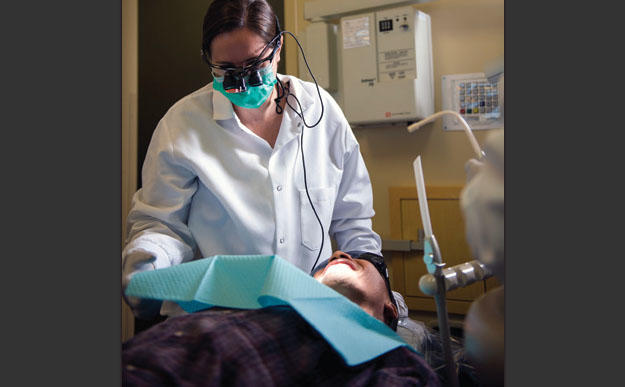Advancing Dental Therapy in Minnesota

Katy Leiviska, MDT ’11, had a hard time figuring out what she wanted to do after college. As a pre-medicine major, she shadowed several professionals and just couldn’t figure out the right path for herself.
Then, she read an article about the University of Minnesota’s new dental simulation machine—and her interest peaked. She shadowed dentists for hours, and wavered on whether to pursue dental hygiene or a doctorate, until her undergraduate advisor opened her eyes to a new opportunity: to be part of the first class of dental therapists to graduate from the University of Minnesota.
“After researching the program, I withdrew every other application and put everything into dental therapy,” she recalled. “I would be able to work in a healthcare field, work with my hands, and serve an underserved population.”
A lot has changed since she graduated in the first cohort of dental therapists in Minnesota in 2011, amid an economic downturn and skepticism surrounding the new profession. Once concerned she might not be able to find a job, she’s now leading an association for her profession and sharing its story.
Leiviska became president of the Minnesota Dental Therapy Organization in 2020, a role that allows her to share the concept of dental therapy in Minnesota and throughout the country and encourage other states to embrace the profession. Accepted as a profession in 13 states and counting, dental therapists are mid-level providers who deliver preventive and routine restorative treatment with a particular focus on increased access to care for those who might not otherwise have oral health options.
As president of the Minnesota Dental Therapy Organization throughout the COVID-19 pandemic, Leiviska has focused on securing Pew grant funding to support virtual opportunities that introduce oral health professionals and the public to her field. Thanks to the help of former MDTA president and clinical assistant professor Danae Seyffer, MDT, the grant resulted in the first ever continuing education focused solely on dental therapy.
“I have always wanted and sought a dental therapy-centered continuing education, but none have ever existed,” Leiviska said. She was happy to change that.
Held in January and February by the School of Dentistry’s Continuing Dental Education, a two-part continuing education webinar explored the history and background of the profession before delving into the practical implications of having a dental therapist within a practice. Two panels of dental therapists and dentists discussed their own experiences serving underserved populations, working under dental supervision, billing insurance, outlining scopes of work, and more.
The continuing education course brought nearly 60 attendees for the first session, and Leiviska is excited that more will be able to access it through CDE Anytime. “Before now, it was difficult to direct interested parties to any one video or article that encompassed dental therapy,” she explained. Now, she can point them toward this course.
The experience was frightening for Leiviska, who didn’t know what to expect and feared attendees might not show up. “But I was so impressed as a presenter. The continuing education program was so helpful.”
Leiviska hopes that having this resource on dental therapy will make an impact for the oral health community and the public. “I hope people can understand the history of dental therapy, how far it has come, and where we can go,” she said. “Mainly, I hope people can see that we’re doing good work and fulfilling what we were created to do: give high-quality, people-centered care to those most in need.”